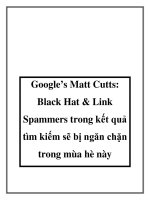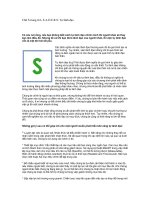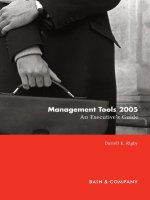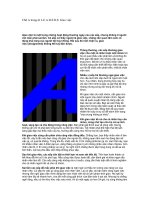Harah’s entertainment
Bạn đang xem bản rút gọn của tài liệu. Xem và tải ngay bản đầy đủ của tài liệu tại đây (40.68 KB, 3 trang )
Chapter 4: Managing Marketing Information To Gain Customer Insight
Company Case Notes
Harah’s Entertainment: Hitting the CRM Jackpot
Introduction
The late 1990s witnessed a rapid expansion of casinos, especially in Las Vegas and Atlantic City, New
Jersey due to relaxations in the US State and Federal gaming laws. New laws had legalised gaming on
riverboats and Indian reservations and this led to intense rivalry between casino operators who started
spending millions of dollars in opening new extravagant properties that featured shopping malls and
hotels in order to attract customers. Harrah's Entertainment Incorporated (Harrah's), an entertainment
company which had business interests in casinos, food & beverages and hotel rooms, decided to
follow a different approach as it realized that about 90 percent of its revenues came from its casino
business and not from associated ventures.
Instead of opening lavish properties, Harrah's initiated a customer relationship management (CRM)
program that aimed at developing long-term relationships with its customers that would enable the
company to capture a bigger market share in the gaming business.
In 1997, Harrah's discovered that its customers spent only 36% of their annual gaming budget at the
company. It realized that increasing customer spends would translate into significant increase in
revenues.
At the heart of Harrah's CRM program was a loyalty programme called Total Rewards (derived from
the earlier Total Gold program) that rewarded customers with comps in order to stimulate loyalty.
The Total Rewards programme was aimed at gathering information about customers and using it to
customize the company's marketing programs for each customer.
Richard Mirman, Harrah's Senior Vice-president of Marketing explained, "We have an advantage in
that we know who the customers are, what they're worth and we can touch them in ways that our
competitors can't even think about." Customers who enrolled in the Total Rewards program were
given an electronic card, which they inserted into the machines they played on.
This card allowed Harrah's to keep track of its customers' preferences and collect data about them.
Harrah's made extensive use of IT to aid the effective use of collected customer data.
A massive data warehouse and business intelligence (BI) initiative was undertaken that enabled
Harrah's to collect and consolidate customer data.
Harrah's then used decision science tools from SAS 1 and Cognos2 on the collected data to better
understand its customers and gain insight into their gaming preferences. Complimenting Harrah's on
its CRM program, Cinda A. Hallman, Former Senior Vice-president of Global Systems and Processes
for DuPont commented, "Harrah's is an outstanding example of a company that is aggressively and
smartly using technology to understand the behaviour of its customers."
Background Note
Harrah's history can be traced back to 1937 when Bill Harrah (Bill) set up his first bingo parlour in
Reno, Nevada, in the Western part of the United States. He went on to buy 'The Mint Club' on North
Virginia Street in downtown Reno. Bill ensured that his customers were very comfortable while they
played bingo. He even had steam pipes installed at the club entrance so that they need not walk on
snow while coming to the club. In the mid-1950s, Bill began acquiring and developing several clubs
at Lake Tahoe in Stateline, Nevada. Harrah's had emerged as a leading name in the casino business by
the late 1950s.
In 1962, Bill went on to build a 400-room hotel tower in Reno. A 400-seat Headliner Room theatrerestaurant was opened in 1966. In 1971, public trading began in Harrah's shares as the company
issued 450,000 over-the-counter shares...
The CRM Program
Harrah's competitors were opening lavish properties that had spas, shopping malls and extravagant
hotel rooms, apart from gambling, in order to lure customers. Harrah's, however, decided to pursue a
different strategy. The company knew that the majority of its revenues came from its casinos and not
from hotels, stores and spas (Refer Table I for business segment revenues)...
Customer Loyalty Programs
The Total Gold program was based on a premise that the best way to improve business performance
was not to attract new customers but instead to get the existing customers to spend more. Harrah's
realized that capturing a higher percentage of its existing customers' gaming budget would
significantly improve the company's profits. This led Harrah's to shift its emphasis towards building
long-lasting relationships with its customers. Customers who agreed to join the Total Gold program
had to fill a membership form through which Harrah's obtained data such as their name, address and
telephone number...
Using Information Technology for CRM
The extensive use of information technology (IT) was central to the success of Harrah's CRM
initiatives. The company's ability to develop and nurture relationships with its customers was a result
1 SAS Institute is a Cary, North Carolina, US based provider of business analytics software. The company reported revenues
of $1.34 billion for the fiscal year ended December 2003.
2 Known as Quasar Systems prior to 1984, Cognos is an Ontario, Canada based provider of enterprise BI solutions. The
company reported revenues of $683.1 million for the fiscal year ended February 2004.
of its ability to capture information and use it to its advantage. With millions of customers visiting its
casinos annually, a significant amount of information was generated...
The Benefits
Harrah's CRM initiatives were the first of its kind in the US gaming industry and the benefits reaped
by the company were impressive. When the Total Rewards program began in the year 2000, Harrah's
was able to capture only 36% of its customers' gaming budget.
By 2002, this figure rose to 43%. The company witnessed a 13% jump in profits in the very first year
of the Total Rewards initiative even after spending $251 million as rewards. The loyalty card
programs had 12 million enrolments in 1997. By 2003, the enrolments went up to 26 million...
Discussion Questions
1. Briefly discuss Harrah’s marketing information system.
2. Describe the relationship between Harrah’s marketing information system and Harrah’s
managers and employees.
3. Why does Harrah’s system work so well compared to MIS efforts by other companies?
4. To what extent is Harrah’s in danger of a competitor copying its system?









